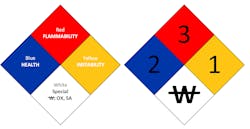Fire & Life Safety: When Labels are a Good Thing
To me, one of the great things about the alarm business is its randomness — one day you may be working in a school; the next day, a warehouse. This changing dynamic of our profession keeps our work fresh and challenging; however, this variety of building occupancies can mean a variety of dangers.
You should be aware of a safety feature the businesses and shipping industries are using to help keep employees, visitors and firefighters safer — the information found on almost all chemical products and containers. This safety information is provided so precautions can be made to properly handle, store and transport dangerous materials.
Imagine one of your own employees working on a Saturday to make a long wire run down the length of a warehouse and trucking terminal. This employee picks up a tool bag from the floor to move on down the building and when the bag brushes against his leg, making his pants wet. The employee looks to find that the bottom of the canvas tool bag is also soaking wet. He uses paper towels to pat it dry as well as to dry some plastic boxes that were sitting in the bottom of his bag. He thought the liquid was probably water, but at the next pull box he notices his fingers are tingling — maybe it wasn’t water. If not, what could it have been? His leg isn’t tingling but his pants are definitely a lighter color where they touched the canvas bag. Now he wonders what liquid is being stored in all those barrels located near the last pull box, and he is nervous as to what the side effects might be.
Luckily for this technician, his supervisor was able to call the warehouse’s security office, which got in touch with the warehouse manager. Fortunately, the manager on duty had been trained on the importance of the messages contained on the special labels adhered to the barrels. The technician was lucky, as the stored liquid was not dangerous, and the manager was able to provide direction as to the best method to wash off the liquid and stop the tingling. As a result of this incident, the alarm company this technician works for now teaches all its employees how to read the labels that must be provided on any dangerous chemicals that they may be found in just about any type of facility.
It’s All in The Label
Here are some of the warning label guidelines prescribed by NFPA and OSHA. OSHA’s labels give long-term health effects as well as short-term dangers to health. For employees seeking help, it should be the OSHA label they look for first, since it contains more detailed and useful information for the employees and public. The NFPA label is used primarily by firefighters to warn them of their exposure risks.
Danger level numbers: As described by NFPA, “Hazard severity is indicated by a numerical rating that ranges from zero (0) indicating a minimal hazard, to four (4) indicating a severe hazard.” Three of the color-coded boxes on the diamond-shaped label lists a danger level —red is flammability, blue is health and yellow is instability.
It should be noted, however, that OSHA uses the opposite numbering system of 1-4, with 4 being the lowest hazard ranking.
Inside the white box on an NFPA label: NFPA states, “The special hazards in use include W, OX and SA.” W indicates unusual reactivity with water and is a caution about the use of water in either firefighting or spill-control response. OX indicates that the material is an oxidizer; and SA indicates that the material is a simple asphyxiant gas (nitrogen, helium, neon, argon, krypton or xenon.
OSHA labels include a product identifier code and contact information about the company that supplied it. They also include fire suppression instructions, first aid instructions and directions for proper usage. Additionally, they provide precautionary statements with accompanying pictograms. Some examples of precautionary statements include:
- Keep container tightly closed. Store in cool, well ventilated place that is locked.
- Keep away from heat/sparks/open flame. No smoking.
- Only use non-sparking tools.
- Use explosion-proof electrical equipment.
- Take precautionary measure against static discharge.
- Ground and bond container and receiving equipment.
- Do not breathe vapors.
- Wear Protective gloves.
- Do not eat, drink or smoke when using this product.
- Wash hands thoroughly after handling.
- Dispose of in accordance with local, regional, national, international regulations as specified.
Greg Kessinger is SD&I’s fire alarm and codes expert and a regular contributor. Email him your fire & life safety questions at [email protected].
About the Author

